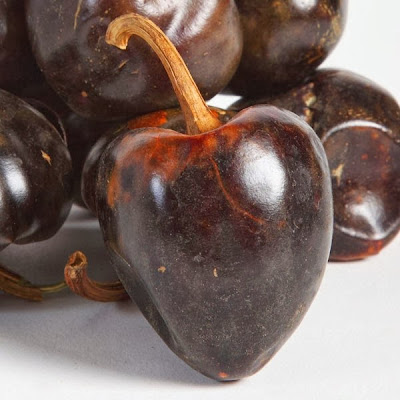CHAP-AZZ-CHILI
Chap-AZZ-Chili
Oh, Chili, oh Chili, how do I love thee. That's right, I just love Chili. Well, that's not exactly true. I dislike Chili made with beans, and historically, in my opinion, it's not the real stuff. People started adding beans because they could not afford meat. There you have it, my Chili is an all-meat Chili, and BTW does not contain any tomato products either.
So hold on to your AZZ and pucker up for a great recipe from yours truly.
I make several versions of Chili. This one contains all re-hydrated Chili's. Sometimes I make alternative chili's that contain some fresh chili's but not today. This is an old fashion bowl of RED.

When deciding to make a bowl of Red Chili, one of the things that cross my mind is the type of meat to use and what Chili's to use.
I chose Chuck because of the texture and flavor. Short ribs would have been great too. Chuck has plenty of fat and connective tissue, and when it breaks down during long stewing, you are left with some great flavor. OK, that was easy. Now what kind of chili's should I use? Number one!!!! Stay away from the plethora of chili powders. Who knows how long they have been sitting on the shelves and what's really in them.

I love all dried Chili's. Some Chili's have a unique flavor profile that I just adore and would work well in Chili.
I chose a variety of peppers to bring out that special taste that I was looking for with that in mind. One Chili I chose is Cascabel Chili. They have a tendency to lose their seeds and, when shaken, sound like a bell hence the name. From my experience, the flavor denotes earthiness, smoke, complex flavors with a little heat.

I also chose Passilla Chili, Ancho Chili's, Mulato Chili, Chili Negro, Habanero Chili, and Chipotle Chilies. Some are sweeter than others, and others have a complex and sometimes chocolaty overtone. One of my favorite Peppers would have to be the Ancho. The Ancho is sweet and smokey. I just love this pepper. The Guajillo Chili is the bomb for Chili's and stews and were added to my Chili too. And last but not least is the Hatch Chili. Suffice it to say I used a lot of Chilies.
So how did I build my Chili? It all starts out with the Meat. Like I said earlier, I used chuck. After choosing my meat and Chili's, I had to come up with meat to Chili ratio. I always stick with the same rule of thumb. 3-4 Chili per pound of meat depending on the size of Chilies. In this particular case, I ended up with about 19 ounces of Chili peppers. This, of course, is before I roasted them, pulled off the stems, and seeded them.

So here is my Chili rule of thumb..... 3-4 Chili per pound of meat, 4 lbs of meat to 1 huge onion, and 1 head of garlic. OK, that is simple, right? What spices do I add? I love Black Cumin and regular cumin toasted to bring out the oils. Mexican Oregano is awesome!!!! Salt and Pepper. I also like to add Mexican chocolate when I have some on hand. Not the powdered stuff either I am talking about the bars. My secret ingredient is honey. Honey cuts the heat and spiciness. Some people use tomato products or even beer to do the same thing.
What to do first? Roast all Chilies except the Habaneros and Chipotles. The Habanero's and Chipotle will be roasted later on and pureed. Keep separate and add for heat as needed later on. Roast Chili's at 350 degrees for about 5-8 minutes. Be very careful; they burn very quickly.
After roasting, take the tops off and remove as many seeds as possible. If you skip this step, you can end up with bitter Chili water.
(see below).
Place all seeded peppers into a large container and submerge with nearly boiled water. Keep peppers below the water surface with a heavy plate. In two hours, the peppers will have hydrated and are ready for the next step.
Previously I mentioned the need to remove the seeds and stems from the peppers after roasting, which is why. Place peppers in batches into a blender and puree with some residual chili water that the peppers were hydrated in.
After you have pureed all the peppers, place them in a sterilized container. Strain all the Chili water through a fine strainer, china cap, or cheesecloth and place it in a sterilized container.


More prep work ahead!!!! While the peppers are sitting in the water bath re-hydrating, start cutting up your meat. If you want, you can cut up the meat the day before. Cut the meat up into one-inch cubes or a little smaller. You could use ground-up meat, which will make your chili smooth and tender due to the fact all the fibers were shortened, but the chili will lack a little flavor. You cannot brown ground-up meat very well.
Chop up all your onions and garlic too. I would definitely cut the meat up the day before but not the onions or garlic.


Like I said earlier, you can cut up all your meat the day before. If you decide to do this, make sure to store in a container and keep it refrigerated.
Now that all the prep work is done, you can start making your chili. In a separate skillet, you will start browning your meat in batches. Salt and pepper the meat while browning. Have a separate bowl ready to hold all your seared meat until ready to start building your chili. The secret to a good chili is caramelized meat, which brings out flavor and texture in your chili.
This browning that takes place is called the Maillard Reaction. What you don't want to do is brown the meat all over and cooked it through. I have coined the term "Maillard Dichotomy of meat." There seems to be a conflict when your sear meat. Searing meat develops a great flavor, known as Maillard Reaction, and creates tougher and dryer meat. So how do
you get tender meat that is also flavorful? Only brown one side of the meat. I am playing around with the idea of searing (maybe next time) large chunks of meat and grinding them all down so all the fibers are shortened, which will provide a very tender Chili but hopefully give lots of flavors because I first browned them off first. We will have to wait for the next batch, I guess.


A huge heavy pot (the one to the left is 40 QTS) starts sauteing your onions and garlic (add salt and pepper). Cook (sweat) them until they are fragrant and soft.
You don't want to add color to the onions and garlic. After you are satisfied with your onions and garlic, toss in your pre-cooked meat and thoroughly mix.
Add your Chili sauce.

Add your Chili water and get it to the consistency you want. Start adding all your other ingredients regarding the cumin and black cumin. I like to toast them first, then grind them to a fine consistency. I add lots of Mexican Oregano and cilantro.
Now add your optional Mexican Chocolate!!!
You are going to want to stir this every few minutes for the first 30 minutes or so. Keep tasting!!!!!! You will have to make several adjustments to seasoning and heat. Remember, you can always add heat, but you cannot take it out. Add your Habanero and Chipotle over an hour or two. In about an hour into the stewing, taste the Chili and add some honey. It is entirely up to you how much to add. If you add too much FIRE by some awful chance, just add some more honey; it will cut the heat. You will want to stew this for at least 4 hours or until you are satisfied with the taste and consistency of the meat. If the meat has not broken down to your preference, use a metal spoon and help it along.

If your chili ends up too thin, you can always thicken it with a roux. Try making a Masa roux using beef fat.
This version of my chili is my base Chili. I like eating this chili by its self or over rice and beans. I also like adding pasta, cheese, green onion, and cilantro and baking it off. I also make Chili dips from it by adding a bunch of other stuff to it. A big bowl of red with onions, cheese, and sour cream is to die for. Just use your imagination, and you cannot go wrong.
OPTIONAL- TO INCREASE BEEF FLAVOR ADD JUST A BIT OF RED BOAT FISH SAUCE.
 |
| SERVE YOUR CHILI WITH RICE OR BEANS OR WHATEVER YOUR HEART WANTS |













Comments
Post a Comment